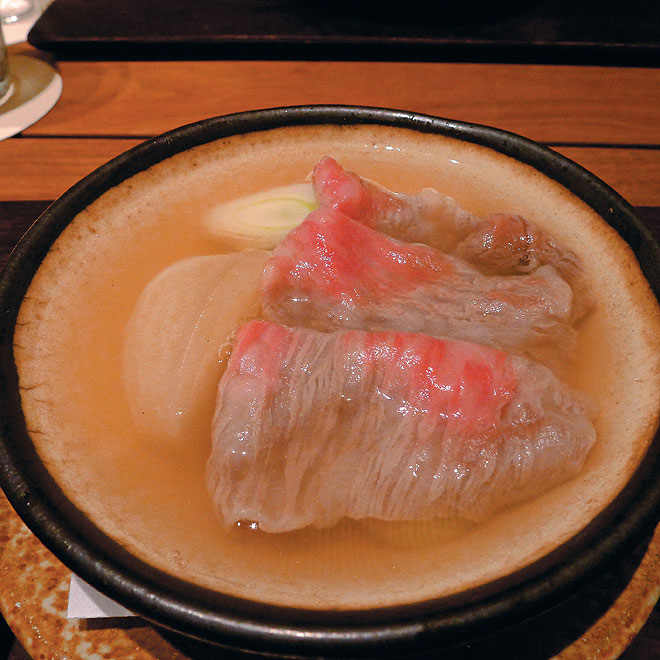On a recent trip to Tokyo, an unexpected windfall (as windfalls generally are) allows
When I mention our forthcoming evening to another Japanese woman she shakes her elegant head. “I don’t enjoy eating at these places.” “Why not?” “Well, it would be different for you, perhaps, but being both Japanese and a woman, these meals can be hellish.” “How so?” “Well, it’s as if I’m also sitting an exam. Whether I’m worthy, whether I can appreciate the food, how I sit, I have to sit very straight, how fast or slow I eat…It’s just not worth it.”
Our crew for the dinner consists of two women and two men, M, D, a Swiss woman of great sophistication and zero pretence, C, the German foodie friend who has fixed upon the place, and myself, R. We take the Metro to Iidabashi station and make our way up a sloping street through the area of Kagurazaka. The area is much smaller in scale than the ongoing explosions of Shinjuku or Shibuya, but quite alive with shops, eateries and bars. At the Bishamon temple, we stop. Standing there, waiting for us is a gracious young woman in a kimono. “Ah! M_san! Please follow me!” The woman leads us up a quiet lane past the temple and through a small, unfussy black wooden gate. In terms of a façade, you could walk past this place, one of the best restaurants in the world, and not notice.
Inside, things are equally without unnecessary pomp or glitter but perfect in that Japanese minimalist way. The establishment has only four tables in enclosed rooms and seven seats at a counter. If you’re looking for a place to go watch the rich and famous eat fancy food, this isn’t it. Here, when you’re seated in your private room, it is you who is special and the food that is the star. In fact, as Ms Sigi, the service manager, welcomes us, the whole business preceding the service feels like some sort of warm, friendly religious ceremony or a preamble to some deep séance or psycho-hypnosis session. The face-cleansing napkins come and go and I find myself looking down at an exquisite pair of double-sided chopsticks, i.e. ones with points at both ends. “One end is for you, the other for God,” explains M. Through the meal this beauty of the small, the understated, the ambiguous, the delicate, will be maintained.
C and I emphasise that we would like to try some of the different types of sake and Sigi unleashes a brilliant smile. “No problem. It will be our pleasure to pair different sake with the dishes. We hope you will enjoy them.” And boy, do we enjoy them. Across the eleven-course meal (under nine headings) the sake and the bottles in which it is served keep changing, some of them accompanied by special cut-glass sake thimbles from the 1930s. All in all, we have five kinds of sake, one of them both hot and cold, the final one complimentary “from Fukushima Prefecture, but guaranteed 100 per cent uncontaminated.”
The food itself is difficult to describe, chiefly because the English language just doesn’t have the words for it. As I eat, or rather, as I ceremoniously, cautiously and slowly allow the different confabulations to enter my mouth, I remember some of the ecstatic writing I’ve read about Japanese cuisine. I now realise just how much of this textual striving has grabbed at approximations of what actually is beyond English and probably, if truth be told, beyond language itself.

There is a moment in the middle of the meal when a seemingly simple thing sends all four of our varied palates into paroxysms of bliss. For my companions, the menu says it’s conger eel with shuto sauce with mashed sweet potato on the side; for me, it’s a cross-section of lotus root perfectly fried in its peel, accompanied by the same sweet potato. The thing that sends us is the soft little bullet of the deep fried sweet potato. It’s rich, it’s subtle but it’s also a strong comforting sweet-blast, reminding me of gulab-jamun and gajar ka halwa while being nothing like either. God knows what switches it flicks in the others but suddenly all of us are making…sounds. Such is the decibel level that Sigi and our waitress actually hurry in through the sliding door, worried that something is wrong. When I see M laughing and reassuring Sigi, I realise that she has hardly been sitting nervously straight-backed through the meal.

As we subside, we realise that it’s not just the little shakarkandhi sausage but the whole procession of dishes that has led up to it: the blowfish, horsehead snapper, sea bream, mackerel and conger eel for the others and fragrant vegetables, the turtle sauce, the somen noodles, the tofu skin garnished with fresh seaweed and the shiitake mushrooms for me. It’s like swimming in a very finely rendered raga of tastes when a wave of a sam suddenly lifts you up. Yes, I know that’s three metaphors sashimied together, but that’s what I mean about the language being unequal to the task.

As the meal moves towards conclusion, other things elate us, the most amazing wasabi and seaweed, thin Wagyu beef, a small pot of duck with six kinds of mushrooms, each tasting different. Finally, Chef Hideki Ishikawa comes in himself bearing a warm pot of freshly harvested rice from his home in Niigata Prefecture. He smiles and bows, an unassuming man, without any of the chef airs and graces one might expect from a star of the most celebrated cuisine in the world. By the time we pile into the taxi we are laughing in wonder. After eleven courses I feel no heaviness at all. As the taxi whips us into the Tokyo night, I realise it’s the spirit that’s replete.


